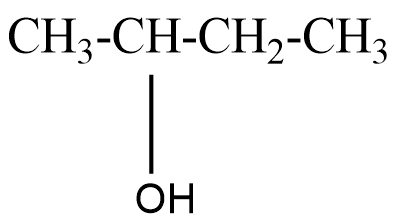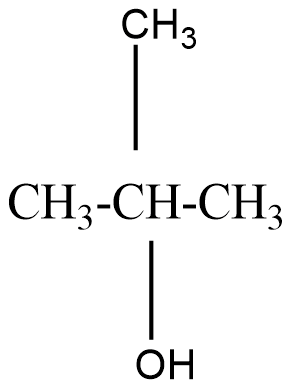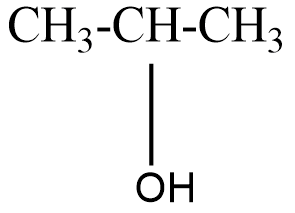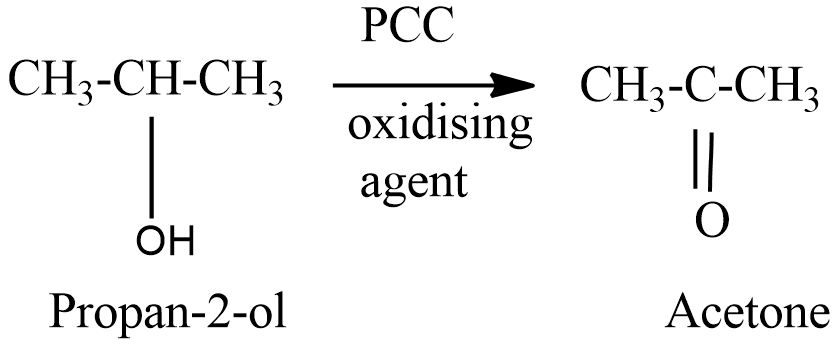
Isopropyl alcohol on oxidation forms:
a) Ethylene
b) Acetone
c) Ether
d) Acetaldehyde
Answer
456.3k+ views
Hint: Iso group can be defined as the structural isomer of a straight chain alkane where the second carbon will be attached to a methyl group. When any functional group is attached to the second carbon, the hydrocarbon will be called as a secondary carbon.
Complete step by step solution:
Alcohols are the functional group where the hydrocarbon is attached to the
When we oxidise the alcohols we get an aldehyde or a ketone depending on the type of carbon where the alcoholic group is attached.
A Primary alcohol will be said to the compound where the alcoholic group is attached to the carbon which is attached to only one carbon. For example,

A secondary alcohol will be said to the compound where the alcoholic group is attached to the carbon which is attached to two carbons in the structure. For example,

A tertiary alcohol will be said to the compound where the alcoholic group is attached to the carbon which is attached to three carbons in the structure. For example,

On oxidation of primary alcohol we get an aldehyde. But on oxidising a secondary alcohol, a ketone is usually formed.
The structure of isopropyl alcohol can be represented as-

On oxidation of isopropyl alcohol, a secondary alcohol we get a ketone namely, acetone.

Hence the correct option is (b).
Note:
There are different oxidising agents that can be used to oxidise particularly aldehyde and ketones, for example
Complete step by step solution:
Alcohols are the functional group where the hydrocarbon is attached to the
When we oxidise the alcohols we get an aldehyde or a ketone depending on the type of carbon where the alcoholic group is attached.
A Primary alcohol will be said to the compound where the alcoholic group is attached to the carbon which is attached to only one carbon. For example,

A secondary alcohol will be said to the compound where the alcoholic group is attached to the carbon which is attached to two carbons in the structure. For example,

A tertiary alcohol will be said to the compound where the alcoholic group is attached to the carbon which is attached to three carbons in the structure. For example,

On oxidation of primary alcohol we get an aldehyde. But on oxidising a secondary alcohol, a ketone is usually formed.
The structure of isopropyl alcohol can be represented as-

On oxidation of isopropyl alcohol, a secondary alcohol we get a ketone namely, acetone.

Hence the correct option is (b).
Note:
There are different oxidising agents that can be used to oxidise particularly aldehyde and ketones, for example
Latest Vedantu courses for you
Grade 11 Science PCM | CBSE | SCHOOL | English
CBSE (2025-26)
School Full course for CBSE students
₹41,848 per year
EMI starts from ₹3,487.34 per month
Recently Updated Pages
Master Class 9 General Knowledge: Engaging Questions & Answers for Success

Earth rotates from West to east ATrue BFalse class 6 social science CBSE

The easternmost longitude of India is A 97circ 25E class 6 social science CBSE

Write the given sentence in the passive voice Ann cant class 6 CBSE

Convert 1 foot into meters A030 meter B03048 meter-class-6-maths-CBSE

What is the LCM of 30 and 40 class 6 maths CBSE

Trending doubts
Which one is a true fish A Jellyfish B Starfish C Dogfish class 11 biology CBSE

What is the difference between superposition and e class 11 physics CBSE

State and prove Bernoullis theorem class 11 physics CBSE

1 ton equals to A 100 kg B 1000 kg C 10 kg D 10000 class 11 physics CBSE

State the laws of reflection of light

One Metric ton is equal to kg A 10000 B 1000 C 100 class 11 physics CBSE




